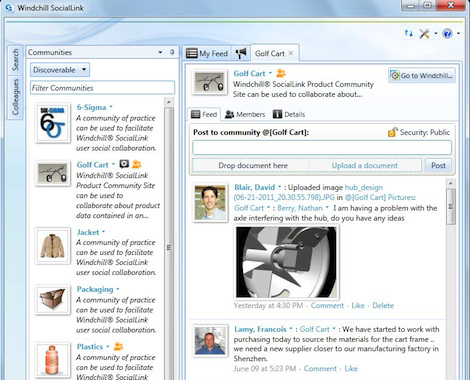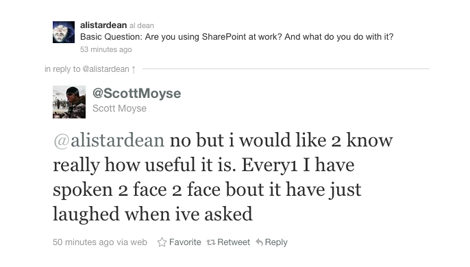
Microsoft’s SharePoint seems pretty innocuous on first consideration. But then you consider how its become a standard, how it’s available, for free, to everyone that’s in a Windows Server environment and how almost everyone knows how to use it. That’s got potential whichever way you cut it. And a couple of things have popped up recently that made me think about it some more.
Firstly, I did a wee interview with PTC’s Erin Daly, who runs the company’s Social Product Development blog (which is also worth a good mooch through) about this after I’d been out to PTC PlanetLIVE earlier this month to see how the company was building some interesting SharePoint-based social media tools directly into both Windchill and Creo.
The tools, known as Windchill SocialLink, take the collaboration out of the purview of Windchill and link directly into SharePoint but link the two. That’s a bonus for those organisations’ tools to spread collaboration outside of the engineering and manufacturing world (i.e. outside of Windchill). Even if they have the permissions, Windchill isn’t a system (even with its much improved user experience) for the non-technical. Whereas SharePoint is ideal. It’s widespread, its Microsoft (so everyone knows how to use it) and it works. And works nicely. The SocialLink tools allow you to kick off a conversation, using SharePoint as the platform regarding specific projects and tasks but with integration back into Windchill.
https://youtube.com/watch?v=sQgd55WqM10
What I find interesting is how PTC’s team is building the enabling technology into both Windchill and Creo that allows you to kick these discussions off. From within Creo, for example, you can grab a screenshot and post it. That’s then available as a visual asset on which other members of a team can base their comments. Everything is shared to those that have permissions and everything is done in the open. If they can scale that to a ProductView (or whatever its called now, Creo Elements Looking at Stuff app?) lightweight visualisation asset, then all the better.
Autodesk & SharePoint
Autodesk meanwhile, doesn’t have this type of functionality, but there are some interesting tools in the Inventor world. Steve Bedder, one of Autodesk’s European tech gurus and pretty damned good blogger just posted a video that shows how you take data from Autodesk Vault (the company’s PDM system). While it’s not as slick as perhaps it could be, it’s usable and makes life a bit easier if you’re looking to share data with those outside of your core design and engineering team.
UPDATE: Steve just emailed me to tell that I’m a wee bit behind the curve on the SharePoint and Vault integration and forgot all that I was shown in Portland a few months ago (The last bits are my words, not his). As he explains, “The video [ed note: the one above] I did is based on Vault 2011 and is in response to a customer question, it doesn’t show the enhanced integration we now have between Vault 2012 and SharePoint 2012. The new integration gives SharePoint users direct access to engineering data within Vault whereas my video shows publishing data from Vault 2011 to SharePoint“.
Here’s that video below and there’s additional details in a press release found here.
Watching this, it’s clear that the Autodesk team are pushing the SharePoint x Vault integration and it looks pretty damned slick without a great deal of messing around using workarounds to push data to SharePoint. Yes, much of this is about Change Request and that’s slightly different to that which we’re discussing here, which is more about informally sparking, enabling, collecting input and opinions based on managed data – but its a damned good start.
Future is coming. Hard & Fast
There’s much talk about how Social Media is coming at the enterprise like a rocket train without any brakes. Oleg’s been discussing it at length on his blog for a while and it’s something that I find highly interesting. As I said in the interview, “There’s a shift coming. Not about technology, collaboration or social platforms but communication. Just that. The next generation has dramatically different expectations in terms of how they communicate with both their peers and seniors. It’s nothing to do engineering or design but all across the board. The next generation of professionals will look to these tools if they’re effective and can be used without interrupting their workflow.”
“So if employers want to get the most out of their employees then they’re going to need to provide an environment that supports this shift. Otherwise they’ll be missing a trick and not getting the best out of the digital kids. The other thing is that they’ll also dump an ineffective tool and work around it. That combination is going to provide a challenge for software vendors. They’re going to have to step up their game in terms of ease of use and workflow integration – otherwise adoption will stall and stall hard and fast.”
Now, SharePoint isn’t Facebook, it isn’t Twitter and it sure as hell isn’t Myspace (poor lonely Tom.. bought out by Justin Timberlake). This is where people have been confused. What’s coming is a new breed of tool that will take the benefits of open collaboration, of clarity of ideas, of feedback and commentary and apply them to an enterprise level system. Yes, it’s most likely to be closed to the outside world and firmly behind the firewall. But that’s not to say it won’t be open to those that can and will have input. What’s changed is that there’s a generation of users coming that actively want these tools.
Consider how design and manufacturing works today. Many companies are split across multiple sites, many of the team members have never met. Social Media tools in an enterprise context have the ability to bring teams together, to foster discussion, dissection and contribution. What’s going to change is that the next generation of users are going to be looking to do exactly that, rather than shy away from it. Openness and exploration amongst peers, amongst a wider team will replace intellectual protectionism.
That’s how the world has changed.
And what’s fascinating, to me at least, is that it’s a company like Microsoft, that’s often seen as a slow lumbering beast, that might hold the future platform for that to happen. Why? Because SharePoint, as silly and innocuous as it may seem, is everywhere. That omnipresence is incredibly powerful. And those specialised vendors that find a way to connect their tools and the tasks their users perform to that platform, stand a better chance than those that don’t. But that’s my point of view. What about those people doing the work and engaging with these tools? What do they have to say on the subject?
Questions for you
I asked a few of the twitter massive about SharePoint and the reactions were mixed. Scott Moyse (whose company you can read more about in the next issue of DEVELOP3D) said this:

Meanwhile, Rod Uding of Barry-Wehmiller had a more positive spin on things. Where he works, the system is being used to share knowledge between departments and each department within each division can see each other’s knowledge. But when I comes to using the vanilla SharePoint tools as a means of collaboration, he had this to say:

Do you use SharePoint at work? What do you use it for? is it used as a storage and sharing place for key documents, for updates to a team, or are you doing something interesting with it. I’m curious to know more. If you’d take a minute or two to add a comment you’d have my eternal gratitude.






